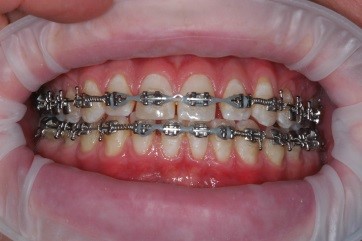Have you been thinking about straightening your teeth and are trying to decide what is the correct option for you? Below we talk about some of the differences between Invisalign® and traditional braces to help you with your decision
Appearance
Invisalign® can be less noticeable than braces. Invisalign® however, does require attachments to be placed on the teeth which are visible regardless of whether you’re wearing the aligners. Some patients prefer the look of clear aligners while others prefer the look of traditional braces. Tooth-coloured braces on your top teeth may be another option if you want a more discrete-looking alternative to metal braces.

Invisalign®
Cost
This obviously varies greatly depending on the extent of the treatment required. However, a general rule of thumb is that Invisalign® will probably cost $1000-$2000 more than an equivalent treatment plan that uses traditional metal braces. Also, the payment plans typically differ in that Invisalign® requires a deposit prior to the treatment starting (up to $4000), whereas braces usually can be paid monthly over the course of the treatment.
Results
For simple to moderate cases, outcomes should not be very different, depending on individual factors (for example, how closely you follow your dentist’s or orthodontist’s instructions at home). For complex cases, Invisalign® may not be suitable or may only be able to deliver limited results.

Regular Braces
Length of Treatment Time
Treatment time is often similar but will always depend on individual circumstances. For both types of treatment, the process can take longer than initial estimates if the teeth don’t move as predicted or the patient isn’t compliant with their aligner/elastic band wear. Sometimes, however, the Invisalign® aligners will stop fitting and new sets need to be manufactured. Generally, this doesn’t cost any more money, but it can affect the treatment time, making Invisalign® less predictable than traditional braces in many cases.
Hassle/Comfort Factor
- With Invisalign®, there are smoother surfaces and no brackets to rub on the cheeks and tongue. But some people with active tongues don’t tolerate the Invisalign® aligner edges well. For example, one of our patients swapped from Invisalign® to traditional braces and found braces much more comfortable for her. For both braces and Invisalign®, it can take a few weeks to adjust to the new feeling.
- When braces are first fixed to your teeth, they might feel sore for 1-2 weeks. This tends to be less common with Invisalign® because the aligners are taken in and out of the mouth regularly, giving your teeth some breaks during the day from the new pressure. When we tighten braces or adjust your clear aligners, your teeth may become a bit tender again. With Invisalign® this happens about every two weeks. With braces, this about every 6-8 weeks, but some patients report soreness lasting a bit longer with traditional braces.
- With Invisalign® can eat what you like after removing your aligners. You can then clean your teeth prior to putting your aligners back in place. You need to wear the aligners 22 hours/day and, if you do lots of
socialising (eating/drinking), you may not be able to get the full amount of hourswear /day required. With braces, your diet is much more limited. You need to avoid really sticky or crunchy things, as you can break the brackets or wires. However, the trade-off is that they are always in your mouth and you don’t need to spend time thinking about whether you’ve worn your aligners for the right amount of time. - Cleaning your teeth with braces on is more difficult as there are brackets and wires on your teeth. Without proper oral hygiene, a person wearing traditional braces may be at a higher risk of decay and gum disease. When you’re using Invisalign®, it can be easier to clean your teeth because the aligners can be removed and the teeth cleaned as usual.

Tooth coloured braces
Follow-up
Both braces and Invisalign® require retainers at the end of treatment to stop the teeth from relapsing back to their original position or somewhere in between. This may include clear retainers which fit over the teeth, a wire, or a combination of the two.
Talk to your dentist or hygienist for advice on what is best for you.
To get in touch about any questions, please contact us today.
*Any surgical or invasive procedure carries risks. If you have any concerns about any risks or other aspects of any procedure, you may seek a second opinion from an appropriately qualified health practitioner before proceeding.




